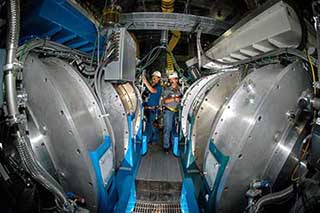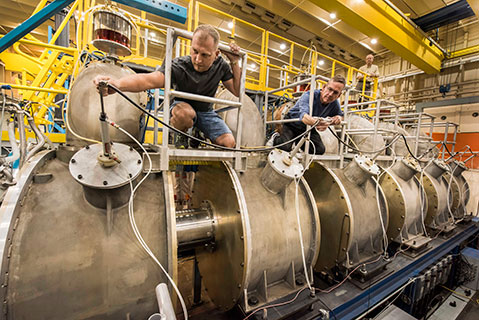Sandia X-ray radiography workhorses reach milestones

CYGNUS MILESTONE — In this photo from 2004, now-former Sandian Isidro Molina, left, and Gene Ormond (1656-1) check over Cygnus. The dual-axis flash X-ray radiography system, which was designed by Sandia and is located at the Nevada National Security Site, has fired its 3,000th shot. (Photo by Randy Montoya)
Two workhorses for NNSA X-ray radiography have reached milestones: Cygnus has fired its 3,000th shot and RITS-6 has fired 2,000 shots.
Cygnus, a Sandia-designed, multi-laboratory dual-axis flash X-ray radiography system at the Nevada National Security Site (NNSS), was originally envisioned for only a single series of subcritical experiments more than a decade ago. Sandia’s RITS-6 facility, a flash X-ray source, has operated for about a decade.
A team from National Securities Technologies (NSTec), Sandia, and Los Alamos National Laboratory (LANL) fired the milestone Cygnus shot Aug. 27. It tested the firing system’s timing to ensure signals for diagnostics get where they’re needed at the right time since a subcritical shot lasts only tens of milliseconds. This was in preparation for a Sept. 23 subcritical experiment called Orpheus, a surrogate materials test in a series called Lyra that will conclude with a subcritical plutonium experiment in 2017.
Experiments by both Cygnus and RITS-6 support nuclear weapons stockpile stewardship.
Performance has to be perfect
“It’s as if you are spending a year practicing for a piano recital, and you can’t make a mistake on the day you are to perform,” says Dan Bozman (16561), team lead for Nevada Support. “If you miss one note, it’s a failure. That one performance has to be absolutely perfect, with it lasting less than a second. It’s a lot of practice, it’s boring, hard to do, and repetitious. On that one day you can’t image how high the tensions are. Everyone is watching, and you don’t want to be the one to miss a note.”
RITS-6, for Radiographic Integrated Test Stand, reached its milestone Sept. 2. RITS-6 develops a flash X-ray source for thick-object radiography, labeled that because things grow thicker as they implode, “so you have to look through a lot of mass with a short duration
X-ray pulse,” explains manager Mark Kiefer (1656). “You have less than one millionth of a second to freeze motion, then there’s a tremendous X-ray dose to see through things.”
It’s a very challenging radiography to take, he says, since “things move very fast because the implosion is created with high explosives.”
Sandia designed Cygnus when LANL needed images to look at the physical properties of plutonium during a subcritical experiment. While getting that ready, Sandia decided to use a vessel to contain the experiments to preserve the facility, which lies 1,000 feet below the desert floor. Cygnus’ identical locomotive-size pulsed X-ray machines, Cygnus-1 and Cygnus-2, can be fired separately, which lets an experimenter capture images at two separate times during an implosion, Dan says.
It’s called Cygnus after Cygnus X-1 of the Cygnus constellation, one of the brightest binary X-ray sources in the northern sky. Cygnus in Nevada has two “arms,” so it’s a binary.
Cygnus, jointly built and operated with Los Alamos and NNSS operator NSTec, originally was intended for a plutonium experiment in 2004, not to exceed 300 shots. Since then, the team has executed five subcritical plutonium shots, each preceded by a multitude of test shots for diagnostics, imaging, and diode development as well as confirmatory shots executed like plutonium shots. They were followed by post-event shots to verify imaging and dose data.
Cygnus, RITS-6 capture important data

Dan says Cygnus’ subcritical tests have generated more plutonium implosion data than all previous subcritical tests combined. At least four more series are expected, with a 4000th shot around 2022.
The facility operates 10-hour days Monday through Thursday. “It’s a grueling schedule, and as we get closer to shot days, the days get even longer and we’ll work Fridays as well,” Dan says. During experiments, the crew stays in on-site housing to be available 24 hours. “The job requirements are excruciating, and this is one of the most dedicated teams I’ve ever seen,” Dan says. Some have been with Cygnus since its beginning.
RITS-6 was built to evaluate flash X-ray sources — very short, intense pulses — for radiography of hydrodynamic testing, Mark says. It uses a type of X-ray source called a Self-Magnetic Pinch (SMP) diode and can be configured various ways, allowing the experimenter to tailor the output for each experiment. RITS-6 has studied many other types of flash X-ray sources.
Sandia operated a demonstration system with one accelerating cavity, called RITS-1, from 2000-2001. A complete accelerator with three cavities, RITS-3, was built and operated from 2002-2005. It was upgraded to its current six-cavity size and renamed RITS-6, which did its first experiment in September 2005.
When RITS-6 was built, its flexibility in creating a very high power electrical pulse for X-ray sources exceeded anything else at the time, Mark says. Over the years, Sandia has operated it with different diodes, and “in that way we’ve fulfilled the mission of why it was built, to test many different types of X-ray sources and find one that meets requirements,” he says.
“We’ve been doing X-ray source development as a way to get X-ray images at a lower cost than other methods,” Mark says. It’s staffed by six Sandians augmented by staff from NSTec, a key participant since the facility’s earliest days.
Over the last year, the RITS-6 staff has zeroed in on an X-ray source producing a very small X-ray spot. “A smaller spot equals better image resolution,” Mark says. “We’ve demonstrated that.”
RITS-6 probably will shut down in December because program requirements have changed. Mark says the program wants at least two radiographic frames along the same view to better see stopped motion during experiments, but the SMP diode can do only one stop-frame. However, it’s likely the facility will be used for a different job in the future, he says.